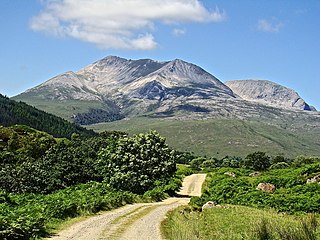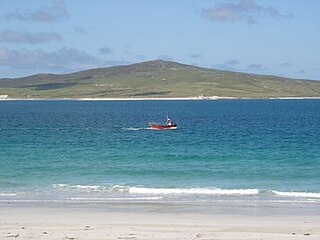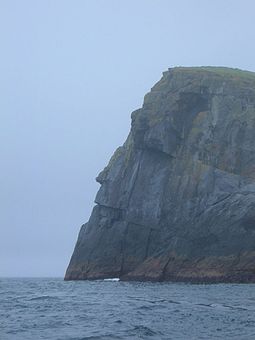
St Kilda is an isolated archipelago situated 64 kilometres (40 mi) west-northwest of North Uist in the North Atlantic Ocean. It contains the westernmost islands of the Outer Hebrides of Scotland. The largest island is Hirta, whose sea cliffs are the highest in the United Kingdom; three other islands were also used for grazing and seabird hunting. The islands are administratively a part of the Comhairle nan Eilean Siar local authority area.

Hirta is the largest island in the St Kilda archipelago, on the western edge of Scotland. The names Hiort and Hirta have also been applied to the entire archipelago. Now without a permanent resident population, the island had nearly all of St Kilda's population of about 180 residents in the late 17th century and 112 in 1851. It was abandoned in 1930 when the last 36 remaining inhabitants were evacuated to Lochaline on the mainland.
Handa Island or simply Handa is an island off the west coast of Sutherland, Scotland. It is 309 hectares and 123 metres (404 ft) at its highest point.
Grimsay is a tidal island in the Outer Hebrides of Scotland.

Sgùrr Dearg is a mountain in the Cuillin on the Isle of Skye, Scotland. It is topped by the Inaccessible Pinnacle, a fin of rock measuring 50 metres (150 feet) along its longest edge. The top of the Pinnacle stands at 985.8 m (3,234 ft) above sea level, making Sgùrr Dearg the only Munro with a peak that can only be reached by rock climbing. This makes it the biggest hurdle for many Munro baggers.

Beinn Eighe is a mountain massif in the Torridon area of Wester Ross in the Northwest Highlands of Scotland. Lying south of Loch Maree, it forms a long ridge with many spurs and summits, two of which are classified as Munros: Ruadh-stac Mòr at 1,010 m (3,314 ft) and Spidean Coire nan Clach at 993 m (3,258 ft). Unlike most other hills in the area it has a cap of Cambrian basal quartzite which gives the peaks of Beinn Eighe a distinctive light colour. Its complex topography has made it popular with both hillwalkers and climbers and the national nature reserve on its northern side makes it an accessible mountain for all visitors.

Ben Macdui is the second-highest mountain in Scotland and all of the British Isles, after Ben Nevis, and the highest of the Cairngorm Mountains. The summit is 1,309 metres (4,295 ft) above sea level and it is classed as a Munro. Ben Macdui sits on the southwestern edge of the Cairngorm plateau, overlooking the Lairig Ghru pass to the west, and Loch Etchachan to the east. It lies on the boundary between the historic counties of Aberdeenshire and Banffshire.
Soay is an uninhabited islet in the St Kilda archipelago, Scotland. The name is from Old Norse Seyðoy, meaning 'island of sheep'. The island is part of the St Kilda World Heritage Site and home to a primitive breed of sheep. It is the westernmost point in the United Kingdom, if disputed Rockall is excluded.

Pabbay is an uninhabited island in the Outer Hebrides of Scotland which lies in the Sound of Harris between Harris and North Uist. The name comes from Papey, which is Norse for "Island of the papar (Culdee)".

Scotland is the most mountainous country in the United Kingdom. Scotland's mountain ranges can be divided in a roughly north to south direction into: the Scottish Highlands, the Central Belt and the Southern Uplands, the latter two primarily belonging to the Scottish Lowlands. The highlands eponymously contains the country's main mountain ranges, but hills and mountains are to be found south of these as well. The below lists are not exhaustive; there are countless subranges throughout the country.

Stac Lee is a sea stack in the St Kilda group off the west coast of Scotland. An island Marilyn, it is home to part of the world's largest colony of northern gannet.

Stac an Armin, based on the proper Scottish Gaelic spelling, is a sea stack in the St Kilda archipelago. It is 196 metres (643 ft.) tall, qualifying it as a Marilyn. It is the highest sea stack in Scotland and the British Isles.

Stac Biorach is a sea stack, 73 metres tall, situated between Hirta and Soay in the St Kilda archipelago of Scotland. It lies west of Stac Shoaigh (61 metres).
![<span class="mw-page-title-main">Oronsay, Loch Bracadale</span> Uninhabited tidal island in [[Loch Bracadale]] on the west coast of Skye, Scotland](https://upload.wikimedia.org/wikipedia/commons/thumb/e/e6/Oronsay_.jpg/320px-Oronsay_.jpg)
Oronsay is an uninhabited tidal island in Loch Bracadale on the west coast of Skye, Scotland.
Stockinish Island is an uninhabited island off Harris, in the Outer Hebrides.

Haskeir, also known as Great Haskeir is a remote, exposed and uninhabited island in the Outer Hebrides of Scotland. It lies 13 kilometres west-northwest of North Uist. 1 km southwest lie the skerries of Haskeir Eagach, made up of a colonnade of five rock stacks, and 40 km (25 mi) northwest is St Kilda.
Boreray is an uninhabited island in the St Kilda archipelago in the North Atlantic.
Events from the year 1899 in Scotland.

John Norman Heathcote was a British author, watercolourist and photographer, who wrote the book St Kilda, published in 1900, about the Scottish Hebridean archipelago of St Kilda.













![<span class="mw-page-title-main">Oronsay, Loch Bracadale</span> Uninhabited tidal island in [[Loch Bracadale]] on the west coast of Skye, Scotland](https://upload.wikimedia.org/wikipedia/commons/thumb/e/e6/Oronsay_.jpg/320px-Oronsay_.jpg)

